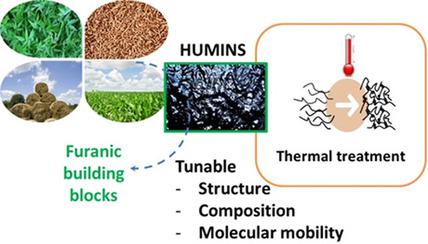当前位置:
X-MOL 学术
›
ChemSusChem
›
论文详情
Our official English website, www.x-mol.net, welcomes your
feedback! (Note: you will need to create a separate account there.)
Humins from Biorefineries as Thermoreactive Macromolecular Systems
ChemSusChem ( IF 7.5 ) Pub Date : 2018-11-27 , DOI: 10.1002/cssc.201802066 Anna Sangregorio 1, 2 , Nathanael Guigo 1 , Jan C. van der Waal 2 , Nicolas Sbirrazzuoli 1
ChemSusChem ( IF 7.5 ) Pub Date : 2018-11-27 , DOI: 10.1002/cssc.201802066 Anna Sangregorio 1, 2 , Nathanael Guigo 1 , Jan C. van der Waal 2 , Nicolas Sbirrazzuoli 1
Affiliation

|
Conversion of lignocellulosic biomass often brings about the formation of several side products. Among these, a black and viscous coproduct known as humins is formed on acidic treatment of polysaccharides. To improve the efficiency of this process from an economical and environmental perspective, new solutions for humins valorization are urgently needed. This work focuses on the comprehensive understanding of humins with special emphasis on their structure/properties relationships. Humins were subjected to different thermal treatments and characterized by means of structural, thermoanalytical, and rheological investigations. The structure and composition of humins are very diverse and depend on the thermochemical conditions. On sufficient heating, humins change into a nonreversible and more branched furanic structure with a relatively high glass‐transition temperature (Tg>65 °C). Thus, humins can be easily processed for preparing thermoset‐like resins.
中文翻译:

来自生物精炼厂的腐殖质作为热反应大分子系统
木质纤维素生物质的转化通常带来几种副产物的形成。其中,多糖的酸性处理形成了称为腐殖质的黑色粘性副产物。为了从经济和环境的角度提高该过程的效率,迫切需要新的解决方案,以实现对人为价值的评估。这项工作着重于对人的全面了解,特别是其结构/性质的关系。腐殖质经历了不同的热处理,并通过结构,热分析和流变学研究进行了表征。腐殖质的结构和组成非常多样,取决于热化学条件。在充分加热的情况下,T g > 65°C)。因此,可以很容易地加工腐殖质以制备类似热固性的树脂。
更新日期:2018-11-27
中文翻译:

来自生物精炼厂的腐殖质作为热反应大分子系统
木质纤维素生物质的转化通常带来几种副产物的形成。其中,多糖的酸性处理形成了称为腐殖质的黑色粘性副产物。为了从经济和环境的角度提高该过程的效率,迫切需要新的解决方案,以实现对人为价值的评估。这项工作着重于对人的全面了解,特别是其结构/性质的关系。腐殖质经历了不同的热处理,并通过结构,热分析和流变学研究进行了表征。腐殖质的结构和组成非常多样,取决于热化学条件。在充分加热的情况下,T g > 65°C)。因此,可以很容易地加工腐殖质以制备类似热固性的树脂。











































 京公网安备 11010802027423号
京公网安备 11010802027423号